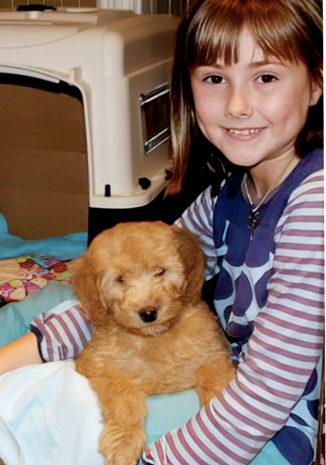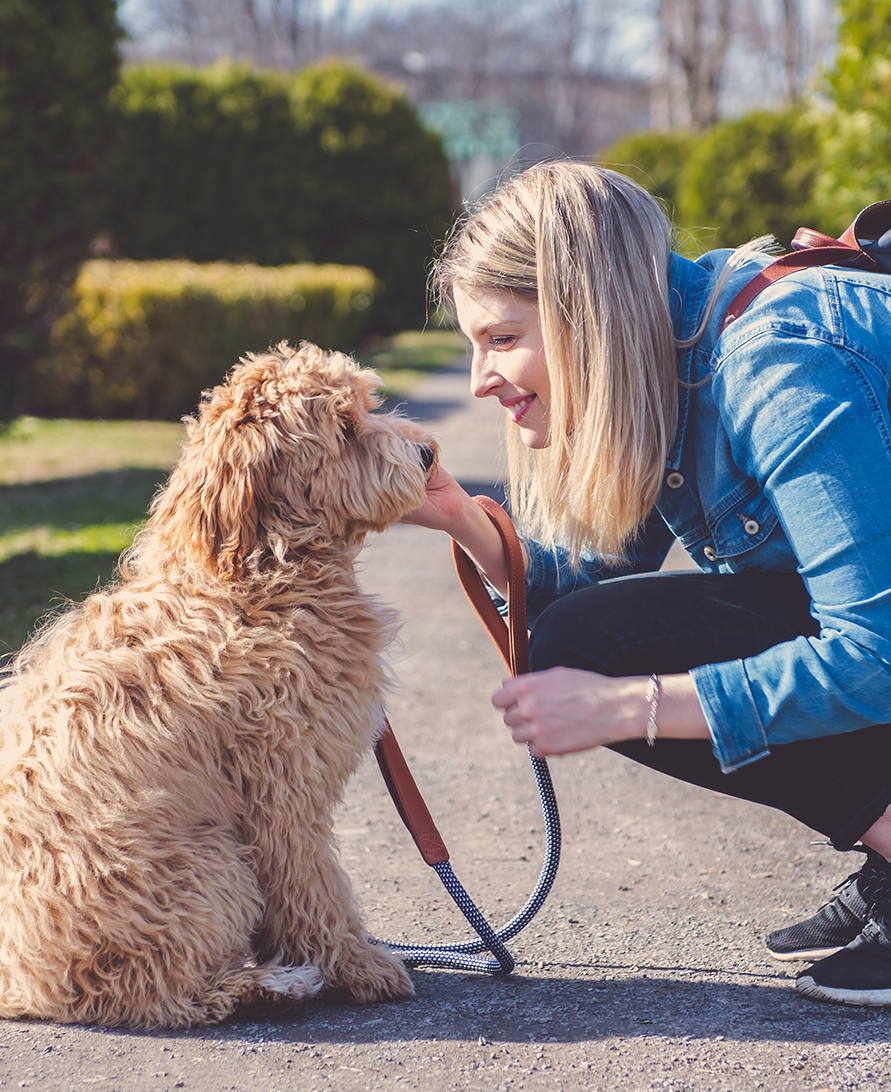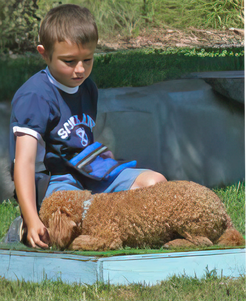Training Your Doodle
Nothing is as rewarding for both the family and puppy as good training. Pups that are well-trained get into less mischief and bond better with their family. Below, we have listed some basics to help new owner’s get started with their puppies. Begin your training with short sessions, no longer than 10 minutes. Stop if you or the puppy become frustrated and try again later. This should be fun!
Sierra Vista Labradoodles encourages puppy families to enroll their doodles in puppy kindergarten. Afterall, everyone deserves a good education! Classes help families and pups to communicate more consistently and efficiently. We prefer positive reinforcement-style training.
Baxter and Bella is one of the most comprehensive and cost effective on line training programs. With our 25% discount code (SIERRA) you can get lifetime access to their classes and consultation for about the same cost as a Puppy 101 class. Check out their website www.baxterandbella.com/learn-more.
For those that live in the San Francisco Bay area, we recommend the Sirius Puppy Training Program https://www.siriuspup.com/.
Sierra Vista Labradoodles encourages puppy families to enroll their doodles in puppy kindergarten. Afterall, everyone deserves a good education! Classes help families and pups to communicate more consistently and efficiently. We prefer positive reinforcement-style training.
Baxter and Bella is one of the most comprehensive and cost effective on line training programs. With our 25% discount code (SIERRA) you can get lifetime access to their classes and consultation for about the same cost as a Puppy 101 class. Check out their website www.baxterandbella.com/learn-more.
For those that live in the San Francisco Bay area, we recommend the Sirius Puppy Training Program https://www.siriuspup.com/.
|
Crate Training
Crate training is one of the tools we feel is very important to use with a new puppy. Some new owner’s are concerned that crating a pup is cruel. Actually, nothing can be farther from the truth. Dogs are den animals in nature. Their instinct is to find a safe, protected area to sleep and relax in. Working with this natural instinct gives owners a great tool to help their pup feel secure while assuring that there is no chewing or soiling in unwanted areas. Crates are never to be used as punishment. This defeats the whole purpose of the crate. Your puppy should love his/her crate. Instinctively, dogs do not want to soil their sleeping area. Crate training makes use of this to help with housebreaking. By giving your pup a routine, you assist them in learning when and where it is appropriate to go “potty”. To crate train your puppy start by leaving the kennel in the puppy’s play area with the door open (hopefully, somewhere near to you. Dogs are social animals and want to be near their “pack”). The pup should feel free to come and go in it. If the pup is reluctant, toss some treats in it or start to feed the pup their meals in it with the door open. Once they are comfortable with that begin to close the door for very short periods of time. Give them chewy treats or Kong Chew Treats stuffed with peanut butter to work on while they are in the crate. Do not push to see how long the puppy will tolerate it. One bad experience can set you back quite a ways. After the pup has been in the crate for a minute, open the door and let the pup out. Gradually extend the length of time with the door closed. Do not praise or make a big deal out of leaving the crate. You want the crate to be associated with treats and good thoughts…not the leaving of the crate. If pups associate getting out of the crate with getting praise or treats then getting out is what they are going to want to do. |
Housebreaking
After the pup is comfortable spending longer amounts of time in the crate you can use it for housebreaking. Remember…small pups cannot “hold it” as long as adult dogs! You need to be reasonable in the length of time you are putting them into a crate. No dog should be in a crate longer than 6 hours at any age (other than to sleep at night). Smaller pups can only stay in their crates for 30-60 minutes. Then they should be taken out to their “potty area” to pee and poop. Take the puppy out and say “go pee” or what ever term you want them to associate with going to the bathroom. Give them plenty of time (10-15 minutes). Try to take them out just after eating (when they are likely to need to go poop) or first thing in the morning. When they go potty PRAISE them profusely! The more they associate a certain spot outside with “The Place” to go potty the more they will want to use that particular spot. Be patient…every child has accidents.
Once they reach 12-14 weeks the time in the crate can be extended to up to 3 hours (working your way up slowly). By the time they are about 4 ½ months old they can be up to the maximum 6 hours.
After the pup is comfortable spending longer amounts of time in the crate you can use it for housebreaking. Remember…small pups cannot “hold it” as long as adult dogs! You need to be reasonable in the length of time you are putting them into a crate. No dog should be in a crate longer than 6 hours at any age (other than to sleep at night). Smaller pups can only stay in their crates for 30-60 minutes. Then they should be taken out to their “potty area” to pee and poop. Take the puppy out and say “go pee” or what ever term you want them to associate with going to the bathroom. Give them plenty of time (10-15 minutes). Try to take them out just after eating (when they are likely to need to go poop) or first thing in the morning. When they go potty PRAISE them profusely! The more they associate a certain spot outside with “The Place” to go potty the more they will want to use that particular spot. Be patient…every child has accidents.
Once they reach 12-14 weeks the time in the crate can be extended to up to 3 hours (working your way up slowly). By the time they are about 4 ½ months old they can be up to the maximum 6 hours.
|
Sit
Have a treat ready. Give the command “sit” and then move the treat backwards over the puppy’s head until the puppy has to sit to allow his/her head to follow the treat (the trick is to keep the treat fairly close to the head as you do this). As soon as the pup’s bottom touches the floor give the treat and PRAISE the pup. Do this several times each day. Try to get your pup to sit before giving their food dish, before going out doors and before crossing the street. This helps to keep the dog focused at times when they can get overly excited about the idea of being fed or going for a walk. It also reinforces the notion that they need to "work" for their rewards. |
|
Down
Start with your pup either sitting or standing. Take a treat, say the command “down” and move the treat down between the pups front feet. This makes the dog reach down to get the treat. Do not give up the treat unless their belly touches the ground. If it does, PRAISE you pup and give them the treat. Repeat this often until the pup lies down reliably. |
Stay
Have your dog sit. Give the command “stay” (or “wait”) and put your hand in front of the pup, palm towards their nose, and take one step back. Then immediately come back and give a treat while praising your pup. Repeat this over and over gradually lengthening the time and distance from the pup.
Have your dog sit. Give the command “stay” (or “wait”) and put your hand in front of the pup, palm towards their nose, and take one step back. Then immediately come back and give a treat while praising your pup. Repeat this over and over gradually lengthening the time and distance from the pup.
Come
Have the dog sit. Give the command to stay. Step away from the dog. Now give the command “Come!” enthusiastically. When the pup comes to you, give PRAISE and a treat. This also works well with 2 people at opposite ends of the yard. One person says “Fido, come!” and praises the pup for coming. Then the other person calls the pup and praises him/her for coming.
Have the dog sit. Give the command to stay. Step away from the dog. Now give the command “Come!” enthusiastically. When the pup comes to you, give PRAISE and a treat. This also works well with 2 people at opposite ends of the yard. One person says “Fido, come!” and praises the pup for coming. Then the other person calls the pup and praises him/her for coming.
Beyond the Basics
With their eager-to-please nature and their keen intelligence, doodles often become the valedictorians of their puppy training classes. There's no need to stop training when you're done with puppy kindergarten. Consider putting all of those great skills to use.
Here are some links to learn more about post-graduate Doodle Studies:
Canine Good Citizenship “First impressions are lasting” as the saying goes, if you want a dog that you can take with you anywhere, he or she must be under voice control. The CGC certification program works with dog owners to help them and their dog cement their obedience skills. Even your grandmother will be impressed with your dogs good manners.
Agility Competition If you find that both you and your doodle have a competitive streak, you might want to consider signing up for Agility competitions.
Therapy and Service Dog Training If you are more of the philanthropic type then you might want to consider doing therapy with your doodle (after all, doodles were originally bred to be service dogs).
Here are some links to learn more about post-graduate Doodle Studies:
Canine Good Citizenship “First impressions are lasting” as the saying goes, if you want a dog that you can take with you anywhere, he or she must be under voice control. The CGC certification program works with dog owners to help them and their dog cement their obedience skills. Even your grandmother will be impressed with your dogs good manners.
Agility Competition If you find that both you and your doodle have a competitive streak, you might want to consider signing up for Agility competitions.
Therapy and Service Dog Training If you are more of the philanthropic type then you might want to consider doing therapy with your doodle (after all, doodles were originally bred to be service dogs).
Sierra Vista’s Health Warranty
|
Our breeding dogs undergo a variety of health testing (OFA or Pennhip, CERF, elbows, patellas, vWd and thyroid) prior to breeding. We strive to breed healthy and sound family pets. Your puppy will come with a 7 day general health warranty and a 26 month genetic health guarantee.
Just as two healthy human parents have the potential to have a child with a genetic disorder, even health tested breeding dogs can produce a pup with a genetic health problem. Should your puppy develop a life-threatening/life-altering genetic health issue within the first 26 months we will reimburse veterinary costs up to the purchase price of the dog. |





